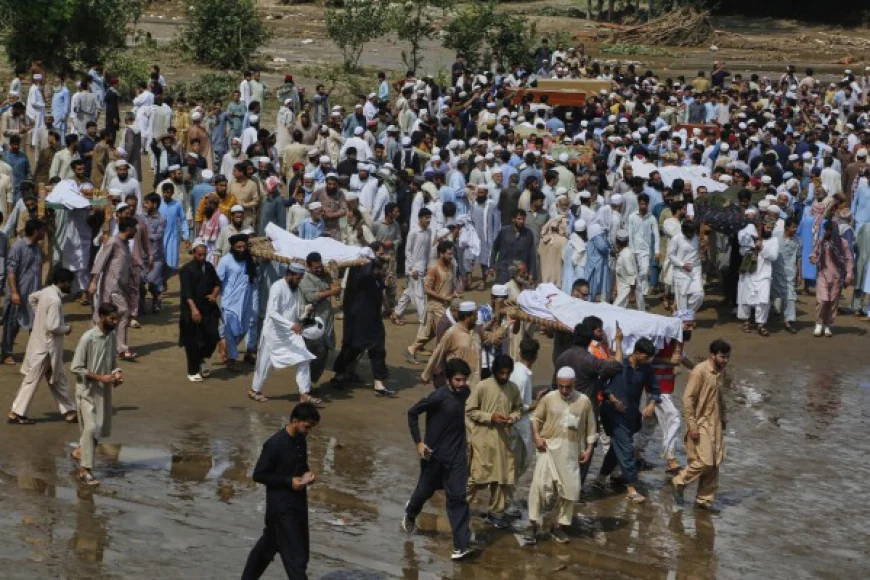Pakistan's Deadly Monsoon
Pakistan is among the top five countries most critically affected by climate change. Every year, Pakistan experiences abnormal and unpredictable monsoons. 670 people have lost their lives due to the monsoon, and approximately 1,000 people have been injured. The infrastructural damage estimate is not confirmed yet.

Earth’s climate change is not a new phenomenon, but it is now occurring at an unprecedented rate. Every continent in the world is experiencing significant shifts in climate patterns. Droughts, heatwaves, flooding, melting glaciers, rising sea levels, and changes in rainfall patterns are among the most pressing concerns of our time. As per the Global Climate Risk Index report, Pakistan is among the top five countries most critically affected by climate change. This year, June was the hottest and driest month, with temperatures reaching as high as 48°C in parts of the country.
Pakistan is the only country that has over 7,000 glaciers outside the polar regions, and these glaciers are melting rapidly due to climate change. Glaciers are considered natural water reservoirs as they melt very slowly, but excessive heat is changing their melting patterns. This shift in weather is contributing to the reduction in the mass and height of the glaciers.

The melting water from glaciers creates small lakes near glacier paths, which sometimes burst and cause Glacial Lake Outburst Floods (GLOFs). These floods not only reduce river flow over time but also affect millions of people and pose a serious threat to biodiversity. Gilgit-Baltistan and Khyber Pakhtunkhwa provinces are home to rare species of plants and animals, and climate change is the biggest threat to their survival.
Traditionally, the monsoon season in Pakistan lasts from July to September, with average rainfall ranging between 250 and 400 mm. In 2024, Lahore, the capital city of Punjab province, received 337 mm of rain in a single day. Every year, Pakistan experiences abnormal and unpredictable monsoons.
Last year, nationwide floods caused the deaths of 234 people. Like in 2024, the 2025 monsoon season remains very challenging for Pakistan, particularly in Punjab, Khyber Pakhtunkhwa, Baluchistan, and Azad Jammu & Kashmir, which is still facing heavy monsoon rains. Due to a cloudburst (extreme rainfall over a small area within a few minutes or an hour), many regions lost their connectivity.
In Punjab, Rawalpindi experienced urban flooding after receiving 300 mm of rain in a single day, which covered streets with water and disrupted daily life. In the Khyber Pakhtunkhwa district of Buner, 150 mm of rain fell in just one hour. Local authorities reported the deaths of 270 people there.
Gilgit-Baltistan was severely affected by the rain, as this region heavily relies on tourism. Due to heavy landslides and flooding, many tourists avoided visiting the area. According to authorities, 49 people died there, and many others were injured.

So far, 670 people have lost their lives due to the monsoon, and approximately 1,000 people have been injured. The infrastructural damage estimate is not confirmed yet, but as floodwaters have washed away many houses, buildings, and livestock, the economic loss is expected to be in the billions of dollars. The National Disaster Management Authority (NDMA) claimed that Pakistan experienced 50% more rainfall than the previous year.
Every year, the displacement of flood refugees and their rehabilitation remain critical issues that need to be addressed seriously. Although NDMA is the authority responsible for strategizing to counter such situations promptly, it has failed miserably in some instances.
Pakistan is among the countries most severely affected by climate change. While NDMA has an advanced early warning and monitoring system, it still relies heavily on the Pakistan Meteorological Department (PMD) for weather data. NDMA should adopt more advanced technology because every year, many lives are lost due to outdated systems.
The government should take action against illegal activities such as deforestation, which contributes to flooding. In many areas, the natural course of rivers has been altered, and the government must enforce serious measures to prevent this. Additionally, the government should develop a comprehensive strategy to address these issues, as the large number of displaced refugees and their rehabilitation remain major concerns every year.


